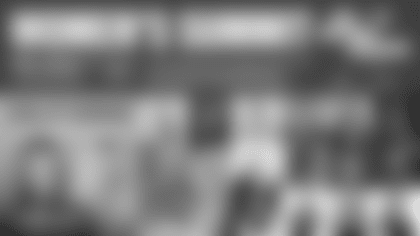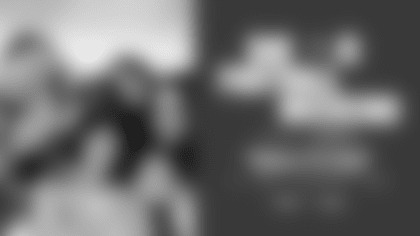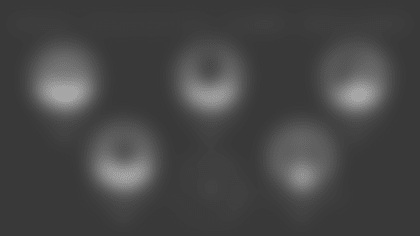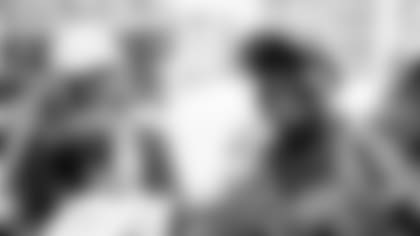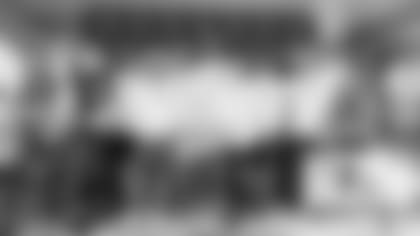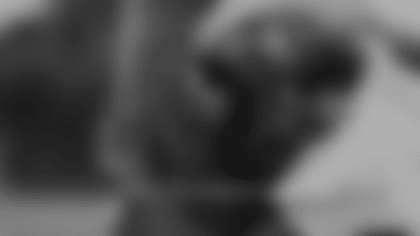One of the jumpers in the elite paratroopers outfit that welcomed the Bucs to MacDill AFB trailed a giant Tampa Bay flag
Eighteen Tampa Bay Buccaneer players spent the better part of Tuesday at Tampa's MacDill Air Force Base, meeting with members of the elite Special Operations Forces of the Army, Navy and Air Force and getting some first-hand military experience.
Those 18 Bucs learned something very important on Tuesday...and it isn't what you think.
Yes, the men and women of our armed forces are the nation's true heroes, but that was clear to each and every Buccaneer before he even stepped foot on the base. The war in Iraq has focused the country's attention on the bravery and skill of our soldiers, and on the daily sacrifices they make to preserve our freedom.
No, the lessons the Bucs learned on Tuesday were far more practical.
Such as, how to activate an MRE, the infamous meals-ready-to-eat that keep the soldiers fed on the battlefield. Or how to sight and fire a long-range rifle, and what that weapon is capable of; how to strap on the necessary protective gear, and why; how to hold and fire a MAAWs, the Multi-Role, Anti-Armor, Anti-Personnel Weapons System and where in a battle it would be used. And much more.
In other words, details.
The Bucs had been invited to MacDill, national headquarters for the United States Special Operations Command (USSOCOM) for a full day of live-action, behind-the-scenes instruction on the forces' training and operational techniques. Many Tampa Bay players jumped at the opportunity, and on Tuesday found themselves fully immersed in the soldier's life.
Among the activities were attendance at a special jump by an elite group of paratroopers; a demonstration of the forces' most advanced weapons, armor and medical tools; several rounds in a simulated battlefield shooting range; a lunch of MREs; and a briefing on the Special Operations Forces by General Charles Holland and Lt. General Doug Brown.
"We got a chance to get out here and see what the soldiers are doing over in Iraq and Afghanistan," said LB Shelton Quarles. "It's awesome to be here today, to be around these soldiers and see what they go through on a daily basis.
"It's definitely a lot of fun. We're trying to understand exactly what they're doing over there, seeing some of their schemes and strategies. It's important to show them that we're interested in what they're doing, because they're doing it to protect our freedom and we appreciate them."
In addition to Quarles, the Bucs who took advantage of this unique opportunity included S John Lynch, CB Ronde Barber, T Roman Oben, G Kerry Jenkins, G Jason Whittle, QB Shaun King, S John Howell, TE Todd Yoder, S Jermaine Phillips, LB Ryan Nece, LS Ryan Benjamin, CB Corey Ivy, LB Justin Smith, DE Corey Smith, T Dan Goodspeed, WR Jermaine White and LB Clayton White. Brown hoped that giving the players a detailed look at the daily demands put on a soldier would make it clear what USSOCOM's success is rooted in.
"I hope they'll take away an appreciation, specifically in Special Operations Command, that we're a people force and that our most important asset is our people," said the general. "We spend most of our energies in to making sure we recruit the right type of people, much like I'm sure (the Buccaneers) do when they're building a pro team. We're building a pro team ourselves and in Special Operations, we have a saying that, 'Humans are more important that hardware,' and so we think we're about building a World Championship team, just like they do."
Lynch absorbed that exact message.
"I think the one thing you see is that it's kind of like football in that you have all kinds of schemes, but it always ways comes down to the heart, the soldiers," said the five-time Pro Bowler. "We have the best technologies, yes, but I think we also have the most skilled military units and their proud of doing their job and you love to see that."
Precision Landings
The Buccaneers' first stop was at the base's Air Mobility Command hangar, where a precisely-timed jump by an elite group of paratroopers was beginning even as the team's buses pulled up. The players hustled onto the vast tarmac in time to see seven jumpers glide expertly down to a small marked area, landing perfectly each time. The paratroopers were led by Master Sergeant Anthony Serrano, a veteran of over 4,800 jumps.
After landing, Serrano presented Lynch with an eight-sided baton that had been passed between the jumpers during free-fall. Serrano told the fascinated Lynch that, even with that many jumps under his belt, each one is different, like a football game.
Serrano and his men enjoyed meeting the defending Super Bowl champs, and were pleased with the atmosphere of mutual respect.
"I think this helps expose us a little bit more to community, to the public, so they can understand what we actually do," he said. "I'm pretty sure they have an idea of what we do, but I don't think they have a full understanding of everything that has to take place before we can do any of this."
Said Barber of the paratroopers' soft and accurate landings, after a fall from 12,500 feet: "It's amazing. They make it look easy. It's like driving a car for these guys, jumping out of an airplane. It's not something I would necessarily do. It's exciting to get to meet these guys and I think they get the same thing out of meeting us. We're their heroes, they're our heroes. It's good to share."
Tools of the Trade
The Bucs were then directed to the nearby hangar, where three tables had been set up in a front corner and loaded with USSOCOM's most technologically-advanced gear. The players were lectured on the features of each weapon, bit of protective armor and piece of medical equipment, and were encouraged to take a hands-on approach.
Among the displayed weapons was an AT4, designed for anti-tank use from inside, buildings, making it the first of its kind. This and many other weapons now used widely throughout all branches of the military were invented by USSOCOM right at MacDill.
Jermaine White, who would later fare well in the simulated shooting range, at one point shouldered the AT4 and aimed at a vehicle at the far end of the hangar. Meanwhile, Phillips donned an entire field outfit – helmet, flak jacket and backpack – and Goodspeed received instructions on loading the MAAWS. One medical officer described the advanced capabilities of the new BMIS-T, or Battlefield Medical Information System-Telemedicine, a device that resembled a palm pilot but allowed for sophisticated battlefield treatment.
Phillips said he suited up "Just to feel what they're feeling. How many opportunities am I going to get to dress up in their gear and feel what they're feeling? What they do for us and what they go through…I'm very impressed. It's like us, in that a lot of people think that we just come out on Sundays and play. They go through rigorous training, just like we do. "
Working Up an Appetite
The next stop on the SOF tour would prove to be the most popular for the players.
Though the buses pulled up to a very unassuming, one-story building, inside was housed an 'Urban Combat Training Facility,' a shooting simulation used to train every soldier on the base. While half of the visiting party was taken into the training area, the other half repaired to the adjacent room for a hearty lunch of MREs.
The simulator had the feel of a giant video game, and a few somewhat comical battles ensued, but the seriousness of the exercise wasn't totally lost on the visitors.
"It just gives you respect for what these guys are going through," said Howell. "This stuff they do is not easy. It's not all toys and fun and games…this is for real, life-and-death situations. It just gives you a newfound respect for what they do to keep our country safe and protect our way of life. This lets us know that when we go to bed every night we're being protected. These guys train every day.
"(The simulator) was pretty cool, but I can't imagine being in a live situation where your life depended on hitting the target."
If it did, the group would be wise to put their lives in Whittle's hands, as the Buc newcomer had the best round of the day with four confirmed 'kills' in one short simulation. Groups of four were alternately thrust into varying scenes ranging from snow-covered forests to open bridges with tanks steaming across.
When not trying their hands on the simulators, the Bucs dug gingerly into a pile of MREs, complete, prepackaged meals that come with their own heating device. Among the main entrée choices were corned beef hash, spaghetti, beef stew, hot dogs, pork chow mein, ham slices, scalloped potatoes with ham and omelets with ham. The hash, stew and chow mein items drew the best reviews from the visitors. Among the typical 'side dishes' were crackers and cheese or peanut butter, pound cake, dried fruit, candy and a cocoa mix that soldiers use to create the very popular 'ranger pudding' when out in the field.
While the MREs were generally thought to be better than expected, they didn't exactly win over a lot of Buc converts.
"And the MREs, the, uh, 'meals?'" said Howell. "I'll tell you what, back at One Buc we think we've got it rough sometimes, but these guys? Those things are horrible. I had the hot dogs and…ugh. I guess maybe you could live off of it, but I wouldn't want to. They say sometimes these guys eat them four or five times a day just to keep their energy up. They go through a lot. I have a lot of respect for these men and women."
General Session
The day's final stop was at the base's Central Command building, or CentCom, where the Bucs met Holland, the commander in chief of USSOCOM. In the building's lobby, Lynch presented Holland with a signed helmet and the general, graciously accepting, drew a parallel between the Bucs' efforts and those of his men and women.
"We'll proudly display that," said Holland. "From one World Champion to another. "You think about what we do and why we're successful, and it's all about teamwork. And teamwork is exactly why the Tampa Bay Buccaneers are World Champions, as well."
After putting the helmet immediately into a display case next, to some personal effects recovered from Manuel Noriega, Holland led the visitors upstairs to a briefing room. After a brief introduction, he turned the floor over to Brown, who provided a detailed look at the history and responsibilities of USSOCOM.
The Bucs learned that the motivation for the rapid growth of the Special Operations Forces was the infamous, failed rescue attempt of the hostages in Iran in 1980. That event occurred just a few years after the Buccaneers themselves were formed in Tampa. In 1987, at the same time a floundering Tampa Bay franchise was trying to right itself with the drafting of Vinny Testaverde, Ricky Reynolds, Mark Carrier and 17 other draft picks, USSOCOM received permission from Congress to set its own budget, making enormous growth and innovation possible.
And in the last few years, while the Bucs were returning to NFL prominence and eventually winning the first Super Bowl title in franchise history, SOF proved its importance again and again in successful operations in Afghanistan and Iraq. Brown sees more conquests ahead for both outfits.
"Special Ops folks train very, very hard," said Brown. "And I'm sure if you watch the Buccaneers as they go to camp and get ready for the next season, it's that same work ethic that our Special Operations Forces have. We train hard, they work hard and the proof is at the end of the day. And I think both of us have been highly successful over the past couple of years."




